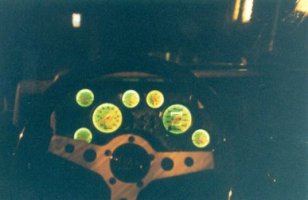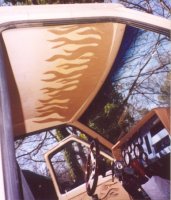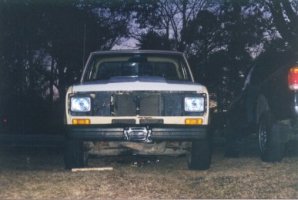Page 1
Page 2 Page 3 Page 4 Page 5 Page 6 Page 7 Page 8 Page 9 Page 10
|
 |
During this time I had been working on the design of the replacement dash, and working at a metals
services company allowed me to implement my design fairly cheaply. This is after the install and wiring, when
I was testing the lighting. The gauges are all Autometer Phantoms, and there are 8 of them. From the lower left
to the lower right: 2-1/16 fuel, 2-1/16 water temp, 3-3/8 10k rpm tach, 2-1/16 boost, 2-1/16 oil pressure, 3-3/8
160mph speedometer, 2-1/16 air/fuel ratio (hidden by steering wheel rim), and 2-1/16 voltmeter. The dash is
aluminum that has been laser cut, bent to fit, and polished. It includes 6 round holes for warning lights and
arrow shaped holes for the turn signal indicators. I was very pleased with the outcome. |
| This is a preview of the interior. The flames on the headliner were cut out of 1/8" hardboard, soaked in water for flexibility, then glued to the ceiling of the truck. This will be covered in light tan tweed. You can see the dash, and the stock Ranger shifter that I stripped, polished, and clearcoated to match the dash. The shifter knob is a cheap Auto-Zone special, but it matches the steering wheel rim pretty well. The door panels are hidden by the shadows, but if you look close you can see that they're flamed as well. |
 |
 | In this shot you can see the cowl induction hood that I got cheap and tossed on there. Currently it's the only external clue that anything is out of the ordinary about the truck, and I would have stuck with the stocker if it hadn't been so cheap. It also was already set up for hood pins, which allowed me to lose the stock latch and make way for the intercooler up front without making it obvious. It's also nice because the 2" cowl rise should give me room to mount an external fuel pressure gauge without it showing when I get around to that. |
| The underside of the rear of the truck. This still has the 6-7/8 rear end with a 3.08 gear in it, which had to go right after getting it running. Most later Rangers came with a 7.5, which is what the turbocharged Fords had until the 87/88 TCs got the disc brake 8.8s. The 7.5 will hold for most of the 2.3T applications because the power comes on after the components are moving, avoiding the initial shock that breaks things. My original plan was to go with a 7.5 with 3.73s and limited slip, but I ended up changing that plan. More about that later. You can also see the gas tank in place in this shot (left, in front of axle), and the Bilstien shocks I ended up with. This is still at stock height. On the right is my hand made aluminum battery box that's mounted to the frame rail. |
 |
 |
|
